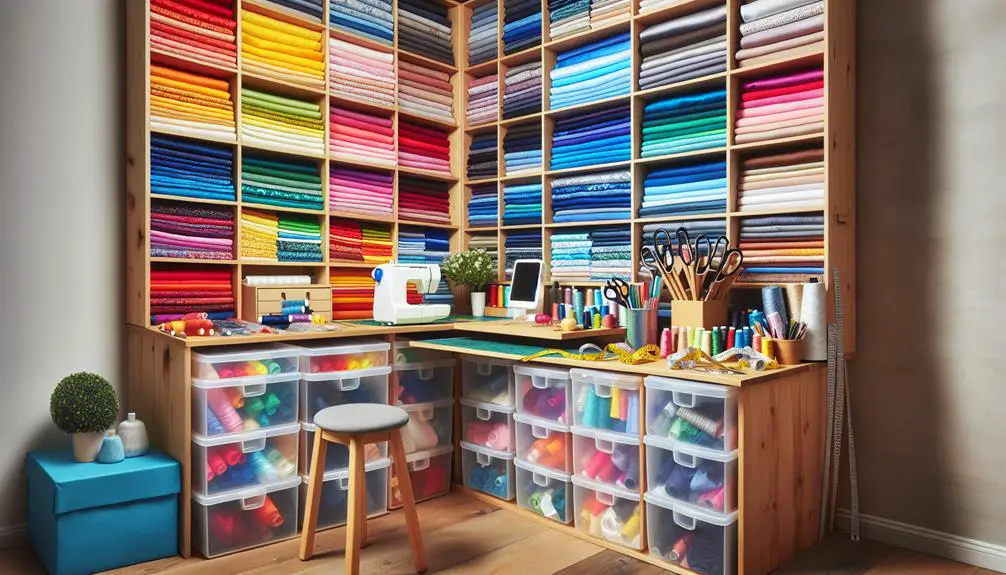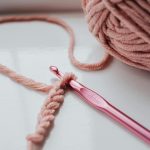When it comes to storing fabrics, how you approach it can greatly impact their longevity and quality. You might think it's as simple as folding and placing them in a drawer, but there's more to take into account if you want to avoid issues like creases, mold, and damage. From selecting the appropriate storage materials to understanding how to handle natural versus synthetic fibers, each step plays an important role. So, how do you guarantee your fabrics stay in top condition for years to come? Let's delve into some key strategies you won't want to ignore.
Table of Contents
Key Takeaways
- Use acid-free, breathable storage containers to maintain fabric integrity.
- Wash and dry fabrics thoroughly before storing to prevent mold and mildew.
- Roll fabrics instead of folding to avoid creases.
- Store fabrics in a cool, dry environment away from direct sunlight.
- Regularly inspect and rotate stored fabrics to ensure longevity.
Choosing the Right Storage
Selecting the right storage method is crucial to maintaining your fabric's quality and longevity. The first step in fabric protection, long term, is choosing the appropriate storage solutions. You need to take into account factors like climate control, accessibility, and space maximization. Opt for storage containers that are acid-free and made from breathable materials to prevent any chemical reactions that could harm your fabric over time.
Organization is key when it comes to storing fabrics. You should categorize your fabrics by type, color, or project to make them easy to locate. Clear, labeled bins can help you see what's inside without rummaging through piles. Additionally, rolling your fabrics instead of folding can prevent creases and save space.
Don't overlook the importance of the storage environment. Fabrics are susceptible to damage from moisture, sunlight, and pests. Ensure your storage area is cool, dry, and dark to protect your fabrics from fading and mildew. Utilizing cedar blocks or lavender sachets can also deter moths and other insects.
Preparing Fabrics for Storage
How do you prepare your fabrics for long-term storage?
Start with meticulous fabric care. Before anything goes into storage, wash or dry clean each piece according to its care instructions. This step removes any oils, dirt, or residues that could attract pests or cause discoloration over time. Don't forget to let the fabrics dry completely to prevent mildew.
Next, consider your storage solutions. Opt for acid-free tissue paper to wrap delicate items, preventing creases and chemical reactions. Fold your fabrics carefully, avoiding sharp creases that can weaken fibers. If you're storing heavier fabrics, roll them instead of folding to minimize stress on the fibers.
Choose breathable storage containers. Acid-free boxes or cotton storage bags are excellent choices as they allow air circulation while keeping out dust and light. Avoid using plastic bags, as they trap moisture and can lead to mold growth. For added protection, place cedar blocks or lavender sachets inside your storage containers to deter moths and other pests naturally.
Label everything clearly. Use tags or labels to note fabric types, dimensions, and any special care instructions. This organization will save you time and preserve your collection's integrity, ensuring you can enjoy your fabrics in pristine condition whenever you need them.
Storing Natural Fibers
When storing natural fibers, be mindful of their unique characteristics and needs to maintain their quality over time. Start by thoroughly cleaning your fabrics to prevent dirt and oils from causing deterioration. Use gentle, pH-neutral detergents to protect delicate fibers like silk and wool.
Once cleaned, make sure the fabrics are completely dry to avoid mold and mildew.
For top-notch fabric preservation, store your natural fibers in a cool, dry environment. Avoid direct sunlight, as UV rays can cause fading and weaken the fabric structure. Place your items in breathable cotton or muslin bags to allow air circulation and prevent moisture buildup. Avoid plastic containers, which can trap humidity and promote mold growth.
To further enhance fabric care, consider using acid-free tissue paper to wrap your fabrics. This will help maintain their shape and prevent creasing. Cedar blocks or lavender sachets can be added to your storage area to deter pests like moths, which are particularly attracted to natural fibers.
Handling Synthetic Fabrics
When storing synthetic fabrics, keep them out of direct sunlight to prevent fading and damage.
Use breathable containers to allow airflow and avoid trapping moisture.
Taking these steps helps maintain the quality and longevity of your synthetic fabrics.
Avoid Direct Sunlight
To prevent fading and degradation, keep your synthetic fabrics away from direct sunlight. Sunlight exposure can cause colors to fade and weaken the fibers over time, compromising the integrity and appearance of your materials. For best fabric protection, store your synthetic fabrics in a cool, shaded area where they won't be subjected to the sun's harsh rays.
When selecting a storage spot, prioritize locations that are naturally dark or have minimal light intrusion. Closets, drawers, and covered bins are excellent options. If you must store fabrics in a room with windows, use blinds or curtains to block out sunlight. Another effective strategy is to place fabrics in opaque containers that shield them from light completely.
Use Breathable Containers
Choosing breathable receptacles is crucial for preventing moisture buildup and mold growth in your synthetic textiles. When picking receptacles, prioritize fabric preservation by focusing on ventilation techniques. Opt for receptacles made of materials like cotton or linen, which allow air circulation and keep your synthetic textiles in excellent condition. Avoid plastic bins, as they can trap moisture and lead to undesired mold.
Consider the following table for prime receptacle selection:
| Material | Ventilation | Durability |
|---|---|---|
| Cotton | High | Moderate |
| Linen | High | High |
| Plastic | None | High |
| Mesh | High | Low |
Breathable receptacles not only allow for air circulation but also reduce the risk of mildew. When you're pondering material considerations, remember that synthetic textiles, like polyester and nylon, require good airflow to stay fresh. Using receptacles with high ventilation guarantees that any trapped humidity can escape, preserving the integrity of your textiles.
To excel in fabric preservation, always keep ventilation techniques in mind. Regularly check your storage conditions and adjust as necessary. By choosing the appropriate receptacles, you optimize your synthetic textiles to remain vibrant and mold-free, ready for whenever you need them.
Prevent Moisture Build-up
Preventing moisture accumulation in synthetic fabrics ensures they stay fresh and free from mold. Start by understanding that synthetic materials like polyester and nylon can trap moisture, leading to unpleasant odors and potential mildew growth.
To counteract this, effective dehumidifier use is vital. Place a dehumidifier in your storage area to maintain an ideal humidity level, ideally between 30-50%. This step is essential if you live in a humid climate or store fabrics in a basement.
Ventilation strategies further enhance moisture control. Guarantee your storage space is well-ventilated by opening windows or using exhaust fans. You might also consider installing a ventilation system if your storage area lacks natural airflow. Proper air circulation prevents moisture from settling on your fabrics, keeping them dry and odor-free.
Don't overlook the significance of regular checks. Inspect your stored synthetic fabrics periodically for any signs of dampness or mold. If you catch any issues early, you can address them before they cause significant harm.
Avoiding Common Mistakes
When storing fabrics, you shouldn't overlook proper folding techniques, as they prevent creases and damage.
Guarantee the storage area maintains a stable temperature and humidity to protect your fabrics from mold and mildew.
Proper Folding Techniques
Mastering proper folding techniques ensures your fabrics stay in excellent condition, free from unsightly creases and damage. Achieving mastery in fabric care involves more than just folding; it's about understanding the nuances that keep your textiles looking their best.
Proper folding techniques are essential for storage solutions that promote longevity and maintain the integrity of your fabrics.
Here are some key tips to avoid common mistakes:
- Use Acid-Free Tissue Paper: Place sheets between folds to prevent creases and protect delicate fibers.
- Fold Along Natural Lines: Follow the grain of the fabric to avoid stress on seams and fibers.
- Avoid Overlapping Folds: Ensure each fold is distinct to minimize pressure points that can lead to damage.
- Store Large Fabrics Rolled: For items like tablecloths or large pieces of fabric, rolling can prevent hard creases.
- Rotate Periodically: Change the fold lines occasionally to prevent permanent creases and wear patterns.
Temperature and Humidity
To maintain your fabrics in top condition, controlling the temperature and humidity levels in your storage area is crucial. Effective climate management guarantees fabric preservation by maintaining a steady environment. Aim for a consistent temperature between 60-75°F (15-24°C). Fluctuations can strain fibers, leading to deterioration over time.
Humidity is equally important. High moisture levels promote mold and mildew, while excessively dry conditions can make fabrics brittle. Ideal humidity levels range from 45-55%. Use a hygrometer to monitor moisture control regularly. If your space is too humid, consider a dehumidifier. Conversely, a humidifier can prevent over-dryness.
Temperature regulation isn't just about setting the thermostat. Avoid storing fabrics in attics, basements, or garages, where temperatures can swing dramatically. Instead, choose an area with minimal environmental variation.
Direct sunlight should be avoided, as UV rays can fade colors and weaken fibers.
Pest Prevention Measures
Maintaining an ideal environment isn't sufficient; you also need to protect your fabrics from pests that can cause irreparable damage. Effective pest control is essential for fabric protection. Start by examining your storage solutions to make sure they offer adequate insect prevention.
First, always clean fabrics before storing. Dirty fabrics attract pests like moths and beetles. Use airtight containers to keep these invaders at bay.
Here are some key steps to keep in mind:
- Clean thoroughly: Wash or dry clean fabrics to eliminate any food particles or stains.
- Use airtight containers: Seal fabrics in plastic bins or vacuum storage bags to prevent pests from entering.
- Add natural repellents: Place lavender sachets, cedar blocks, or other natural repellents inside storage containers.
- Regular inspections: Check stored fabrics periodically to detect any early signs of infestations.
- Maintain cleanliness: Keep storage areas clean and free from dust and food crumbs.
Regular Maintenance Tips
Regular maintenance of your stored fabrics safeguards they remain in excellent condition for future use. Start with fabric rotation and inspection every few months. Rotating your fabrics guarantees even wear and helps prevent permanent creases.
During inspections, look for signs of damage or infestation. Early detection allows for timely intervention, preventing extensive harm.
Consider vacuum sealing for long-term storage. This method minimizes exposure to air and moisture, both of which can degrade fabric quality over time. When using vacuum sealing, make sure the fabric is clean and completely dry to avoid mold and mildew growth.
While mothballs are a traditional choice for pest prevention, be cautious. They contain chemicals that can be harmful if not used correctly. Instead, opt for cedar blocks or lavender sachets as natural alternatives to keep pests at bay without the harsh chemicals.
Lastly, maintain a controlled storage environment. Keep the storage area cool, dry, and dark to protect fabrics from light and humidity damage. Invest in a hygrometer to monitor humidity levels and use dehumidifiers if necessary.
Regular maintenance combined with these best practices will preserve your fabrics, safeguarding they're always ready for use.
Frequently Asked Questions
How Can I Prevent Fabric Colors From Fading Over Time During Storage?
Oh, so you enjoy faded fabrics? For color protection, avoid UV exposure by storing fabric in dark places. Use proper fabric folding techniques and guarantee good ventilation to keep colors vibrant. Master these tips, and thank me later!
Is It Safe to Store Fabrics in Plastic Bins?
Yes, you can store fabrics in plastic bins, but be aware of plastic bin risks like moisture buildup. Use silica gel packets for moisture control to prevent mold and mildew, ensuring your fabrics stay in top condition.
Can Fabric Softeners Affect Long-Term Fabric Storage?
Fabric softeners can absolutely wreak havoc on your fabrics' longevity! They may smell heavenly, but their impact on storage methods is significant. Over time, they can degrade fibers, affecting the overall quality and lifespan of your stored fabrics.
How Do I Deal With Fabric Moth Infestations?
To handle a fabric moth infestation, you should first clean affected areas thoroughly. For fabric moth prevention, use natural remedies like cedar or lavender. If the problem persists, consider professional treatment to guarantee complete eradication.
What Are the Best Conditions for Storing Antique Fabrics?
To store antique fabrics, you need to guarantee climate control and use proper preservation techniques. Maintain low humidity levels and store the fabrics in acid-free materials. This prevents deterioration and keeps your fabrics in pristine condition.
- How Does Ring Spun Cotton Affect Garment Fit and Shape Retention? - August 13, 2024
- What Are the Challenges in Producing Ring Spun Cotton? - August 13, 2024
- Is Ring Spun Cotton Suitable for Plus-Size Clothing? - August 13, 2024







